California winters are a mixed bag. Cold weather, rains, sleeping plants and of course scion exchanges. After the scion exchanges in January I get antsy for fruit and looking at pictures isn’t enough.
This February I packed up my family – plus my parents, my brother and our significant others into the plane to our timeshare in Princeville on Kauai. We’ve been to Kauai several times and each time we’ve been able to experience something new. This time was no different. Having done all of the usual tourist activities, and seen the recommended botanical gardens (National Tropical Botanical Gardens are a must), I opted this trip to find more local growers to get a real feel for Hawaii fruit life.
A week before our trip I put out a request to the Hawaii Tropical Fruit Growers (HTFG) for any Kauai growers that would be willing to talk with me and share what they’re growing. This led me to the Kilauea Saturday farmer’s market. Farmer’s markets are your best bet to finding tropical (rare) fruit in any tropical locale and Kauai is no exception. On Kauai spread across the island you can find several farmer’s markets any day of the week.
On this trip I loaded up early on essentials – apple bananas, Solo papayas, avocados plus I lucked out finding starfruit, black sapote (Diospyros nigra), star apple (Chrysophyllum cainito), sapodilla (Manilkara zapota), soursop, canistel (Pouteria campechiana) and a big bag of longans. On other trips, depending on what’s in season, there are plentiful lilikoi (Passiflora edulis), lychee, mangos, mamey sapote (Pouteria sapota) and mountain apples (Syzygium malaccense)
At the Kilauea farmer’s market I connected with David W., head of the Kauai chapter of the HTFG. David is usually there every Saturday selling fruit from his farm. I spotted his booth right away – he was wearing a HTFG shirt, plus he had his fruit well labelled. They weren’t just generic avocados, he had his labelled as ‘Sharwil’. He had some perfectly ripe sapodilla and black sapote that I had to have.
We quickly started talking fruit, and to the dismay of my family, didn’t stop for 30 minutes. By the time I left I had his number and a plan to tour his farm.
The very next day we headed over to David’s farm – a 30 acre well laid out paradise sitting right above the ocean. David’s had the farm for over 20 years. As we pull up my eyes are immediately drawn to the row of mangosteen ( Garcinia mangostana) trees. David had a great story about these trees. Turns out his neighbor didn’t want them (shocking!) and was selling them for $100 each. These 20+ year old trees were a steal – and despite mangosteen trees being very difficult to transplant, most survived. These trees all produce fruit today. Unfortunately, the season had just ended. David grabbed his fruit picker and we hunted through the trees for fruit. We spotted one! But, when we got it down it was a disappointing dried out mummy.
Down at the end of the row was a durian – disappointingly out of season. Rounding the next row were several large langsat (Lansium parasiticum) trees each with a huge wind shelter built around them. The trees were growing up well above the wind shelter and I was puzzled as to why he kept the shelter in place. He said that when he went to remove them, despite the whole tree looking healthy, he noticed that the trees were only fruiting up to the height of the shelter. So even though the trees have outgrown them the windbreaks remain.
Next up we walked through the mangos. He has at least 100 mango trees – but he only grows about 10 varieties. The trees are pruned to about 20’ tall and are given ample space between each tree for ease of picking. We didn’t linger long on the mangos because there weren’t any to taste.
We then headed back to our cars – when there are 30 acres to see and spontaneous torrential downpours are frequent having a car always nearby makes the touring easier. Along the way we passed more papayas, a ‘Namwah’ banana, large lilikoi vines, a loaded jackfruit (Artocarpus heterophyllus) tree and a large black sapote.
Driving to the next field area he pointed out a row of papayas next to a windbreak. When he pruned back his windbreak there suddenly was a lot more light hitting the ground nearby. Along the whole windbreak papayas were sprouted up everywhere. The whole row of papayas were all seedlings of unknown origin but all were heavy with fruit. He gave us several to try, each had a different hue of orange inside and they were all excellent.
We came to his favorite jackfruit tree – a tree with long more slender fruit than any other jackfruit tree I’ve seen. He shared the fruit with us and the carpels were intensely sweet with a bright orange hue – almost cloyingly sweet like chempedak I’ve had. We later had the seeds from this fruit boiled – they are very similar to chestnuts if boiled until soft.
Rounding the next corner we saw another wonderment – a long row of the largest sapodilla trees I’ve ever seen. All were 20’ tall and absolutely loaded with ripe fruit. We of course had several of these and they were so much better than the store bought ones. These ones divided nicely into wedges and melted in the mouth with intense brown sugar flavor.
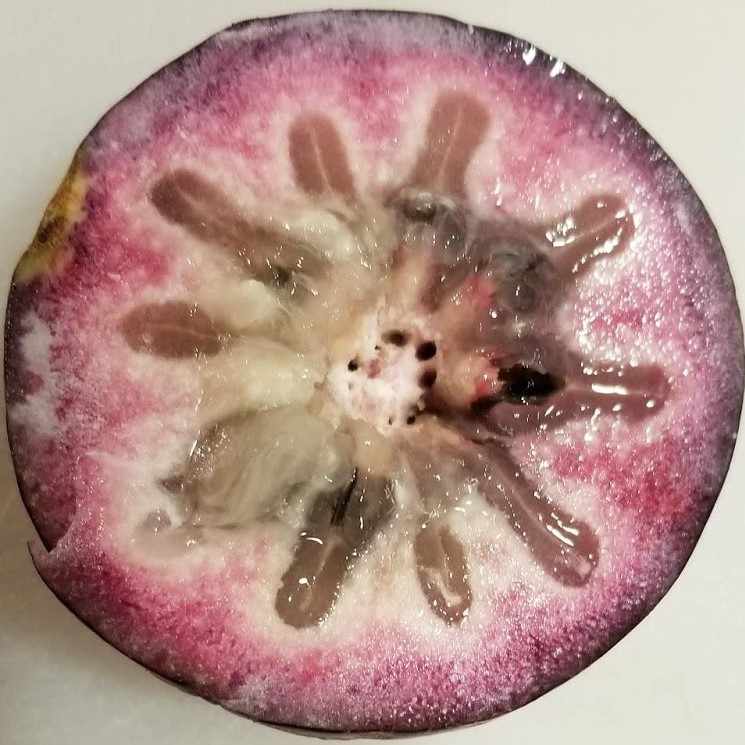
In the next section we spotted the star apple trees and I had to see them. I’ve had many star apples and they’re one of my favorite fruits, but it was a new experience to be hunting through the trees trying to spot the first ripe fruit of the season. The leaves are green on top and brown underneath, the green fruit ripen to a purple and with the mix of colors spotting them was a good hunt for my family. We filled our arms with star apples until we had more than enough for the rest of our vacation.
Next David showed us one of the fruits he was most excited about growing – citrus. He had a large variety, however, his citrus trees looked sickly and weak compared to our California grown trees – the fruit a mottle of green and orange. They didn’t have Huonglongbing (HLB – citrus greening) yet. He explained that a new invasive termite had moved in and rather than feeding on just dead wood this variety was feasting on the living trees and starting to kill them all. He said ultimately his whole orchard was doomed – a reminder that it isn’t all paradise.
We next headed down to the bottom of his farm overlooking the ocean and secluded beaches. Coconuts were popping up everywhere. The landscape was a mix of strawberry guava and java plum (Syzygium cumini), both uninvited invasives. After trying some strawberry guava he remembered that we had to try sprouted coconut. He casually yanked up a young coconut tree – something that would leave us aghast if done in California and took to it with a machete. The coconut had sprouted, the insides had transformed from water into something solid. Once the coconut was opened we pried out the hard insides. Slicing it up for everyone to try we all were eager to try something new. The texture was a bit like styrofoam (like a Syzygium fruit) with a sweetish coconut flavor. It reminded me of an ice cream bean (Inga sp.) After the first few bites our eagerness faded – the novelty had worn off and we discarded the other half.
A combination of pouring rain and grumpy kids forced us to conclude our tour.
I stayed back and chatted with David some more, he was a fount of knowledge for tropical fruit. I asked him, “David, besides the mangosteen are you growing any other Garcinias?”. He immediately reached into his pocket and pulled out a bag for me. He somehow had a bag of lemon drop mangosteen (Garcinia sp.) seeds in his pocket. He was continuously surprising me with his generosity.
He next pulled out a name and number for another grower, John A., for me to visit. While David had a lot of a few trees, John was trying to have at least one of every tree.
In between visits I found a ton of Coconut, False Kamani (Terminalia catappa) and Madagascar olive (Noronhia emarginata) trees along the beaches. David had told me about the Madagascar olive and that they were edible. I of course was obligated to try them and I can report sweet flavors in the scant flesh surrounding a large seed – and a ton of worms. The largest problem with soft-skinned fruit in the tropics is the nearly guaranteed presence of larvae in nearly every fruit. We used rocks and knives and did the obligatory opening of a coconut and having my kids fight over who gets to drink the water. The False Kamani nut was a whole different level of challenge to open. False Kamani are present on nearly every tropical beach, their fruit making a mess but leaving behind the corky seed capsule. These capsules are really good at floating, hence their proliferation. I’d tried on several other trips to open them to get the nut inside but the capsule laughed off my attempts. Bashing it with rocks and sawing at it with knives barely made a dent. It took me a few days and a lot of effort but I finally managed to get one open. What was inside was a seed – about the size of an almond sliver with about the same flavor. Needless to say I was happy to have tasted it but glad I won’t ever need to open one again.
I also saw several of the popular Noni trees I could have picked from – but I know better than that. The foul cheese smelling fruit have no place in my life.
A few days later I texted with John and made plans to visit his place. This time I left the family behind so that I could see absolutely everything with no distractions.
John’s property is in the hills above Kapaa near a popular muddy waterfall hike. I anticipated mosquitos and they didn’t disappoint. We met up in the evening – John still has a dayjob but his passion for the last 8 years is growing fruit. He has 5 acres up a narrow road, across a stream and up the hill. The first thing I saw were the row of blackberry jam fruit (Rosenbergiodendron formosum) shrubs. We popped some of the yellow hard-shelled fruit open and they were filled with a seedy black goop. The flavor was reminiscent of blackberry jam plus perfumy flavor. Despite having hardly any substance in them to eat they are a fun novelty plant to grow.
Because of the time of year and the age of his trees, all less than 8 years old, not a lot of fruit was available for sampling or viewing. We passed several varieties of Jaboticaba trees (Myrciaria sp. and Plinia sp.), notable for their reluctance to bear fruit for years. I tried to keep mental notes and take good pictures but the sheer number of tree species he had (at least 300) overwhelmed me.
We headed down hill and I spotted a black sapote tree with softball sized fruit. He offered me some but I declined, they take several days to ripen and eating an unripe one is like eating an unripe persimmon.
Next I spotted an atemoya with some very large fruit developing, they grow better in Hawaii than our California cherimoyas. We came upon a gigantic fruit hugging his chicken coop. It was an oysternut (Telfairia pedata), a vine producing a very large gourd-like fruit. The seeds of the oysternut are the main prize. Unfortunately, he’d promised to share this fruit with another friend so I didn’t get to try it.
Walking around the border of this section were columnar Davidson Plum (Davidsonia sp.) and Cut Nut (Barringtonia edulis). A small hedge of spiny Salak palm (Salacca zalacca) looked like a future dangerous harvest. It was hard to tell what was jungle and what was fruit trees as they all blended together.
We headed down to the other half of his property over on the other side of a small creek and we saw a herd of wild boars. They spooked a bit and ran. A minute later his hunter friend showed up with bow and arrow ready to hunt them down. We moved on to avoid messing up his hunt but not before I painfully acquired a few naranjilla (Solanum quitoense). Every fruit I tried to grab with my bare hands I winced in pain. The spines were everywhere. Even with a knife they were a chore to pick. Opening them – they weren’t the most choice. Mostly seeds and scant juice, clearly not one of the improved varieties.
The second half of John’s property is along the hills surrounding his long driveway. Most of the plantings here are younger, 1-2 years so few were fruiting yet. It was here that we found various mangosteen relatives (Garcinia sp.) thriving along with large clumps of bananas and papayas. He did have a large Rollinia deliciousa with fruit nearly ripe – unfortunately I didn’t get to indulge on any of these lemon meringue flavored fruits. We picked a branch of patchouli which smells exactly as you’d expect. Vining along one tree was Black pepper (Piper nigrum), tasting just like black pepper only ‘greener’ and more intense. We stopped by an achiote tree (Bixa orellana) to pick some pods. This tree is known as the lipstick tree and imparts the orangish red color to anything it touches, including many foods like cheddar cheese. We figured its natural makeup for my daughters to play with.
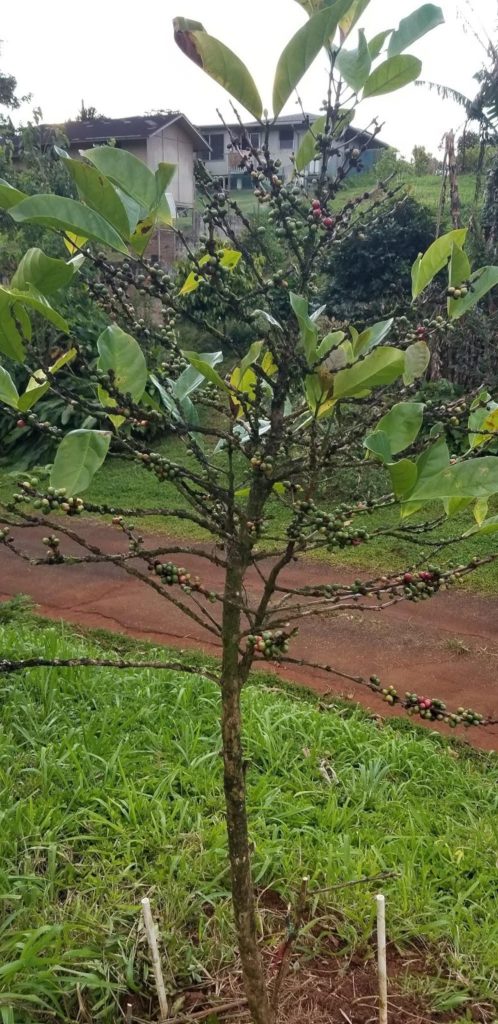
A newly planted Coffee tree with more fruit than leaves 
Ginberry, a citrus relative with small refreshing citrusy fruit
He had just purchased a new coffee tree and looking at it you would think it was infested. There were few leaves and it was covered in bumps. Turns out these are all coffee berries in various states of ripeness and this particular one is very prodigious. Wrapping up I tried a ginberry (Glycosmis pentaphylla), a citrus relative about the size of a pea. It had a slightly spicy grapefruit like flavor. It was fun but definitely is a minor fruit.
With darkness impending I said my thanks to John and headed back with my haul.
Jason Sutor pushes climate boundaries by experimenting with many tropical and subtropical fruit species (including some of the above) at his own Monterey Co., California home, and has graciously shared much unusual plant material among the MBCRFG community. –Editor
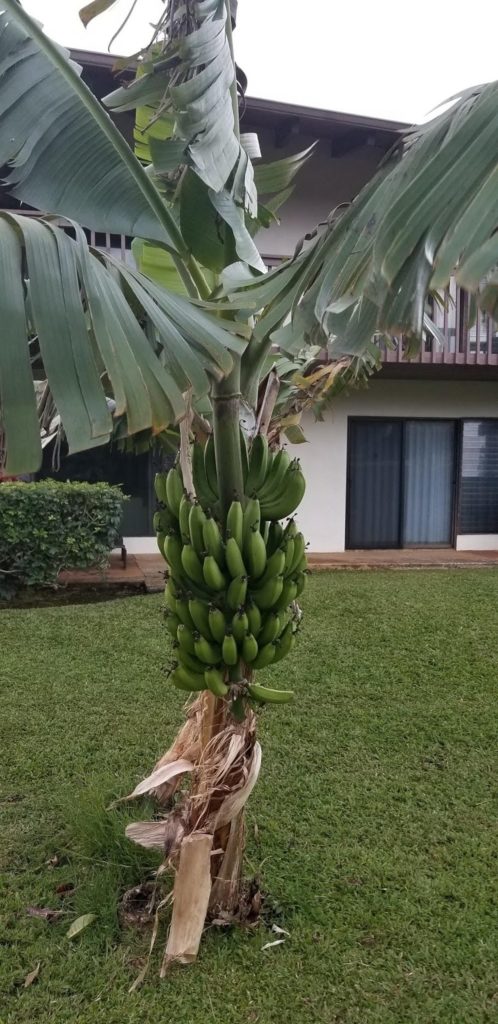
Bananas at our timeshare 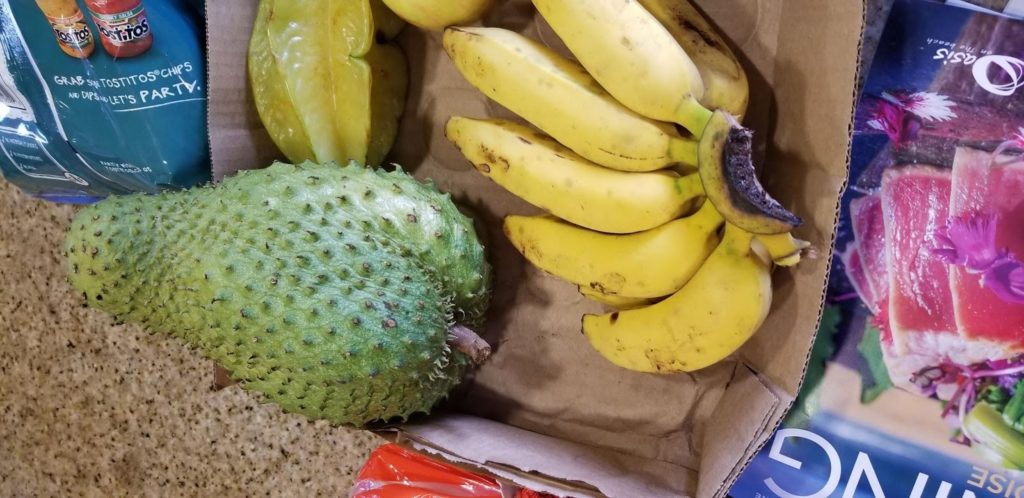
Apple bananas, soursop and star fruit 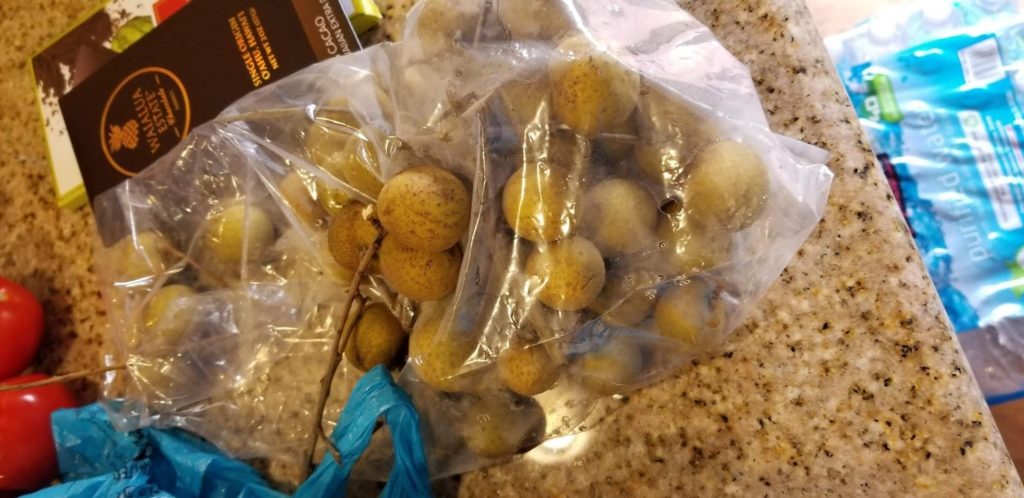
Bag of longans 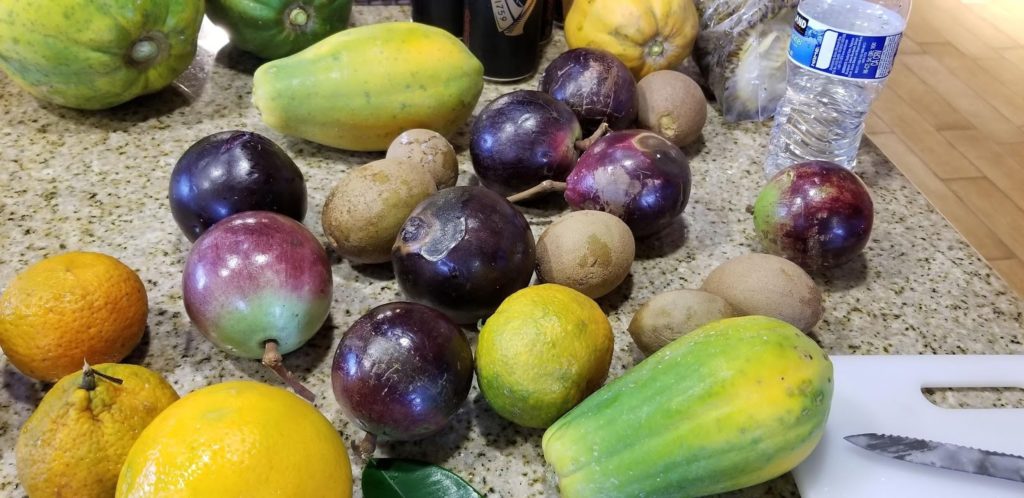
Part of our fruit haul 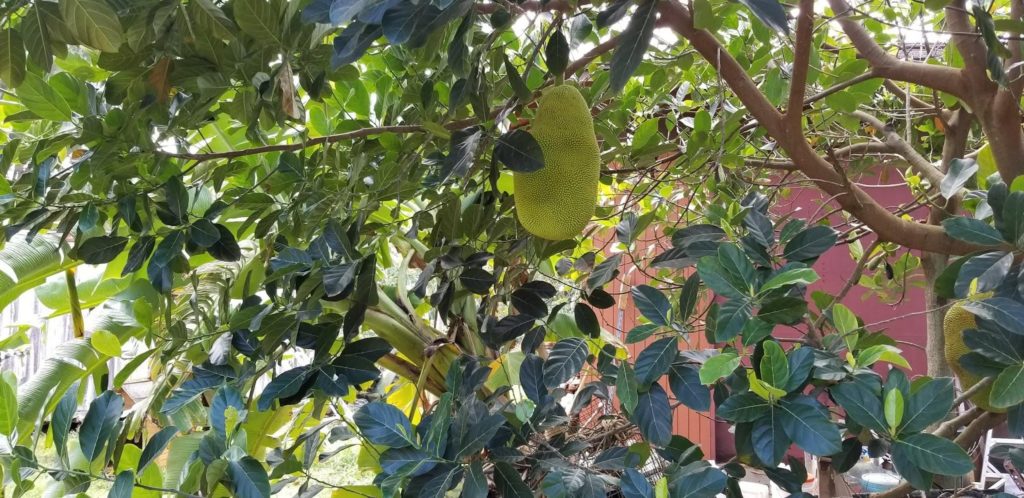
Jackfruit trees here are loaded with giant fruit 
Large avocado he gave me – never did ripen before our trip ended 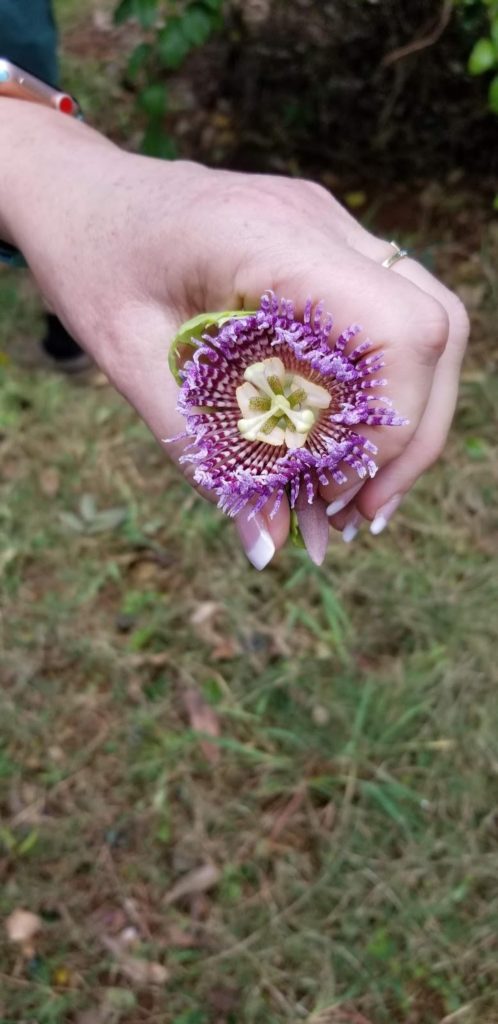
Jamaican lilikoi (probably Passiflora laurifolia) 
Hawaiian yard art 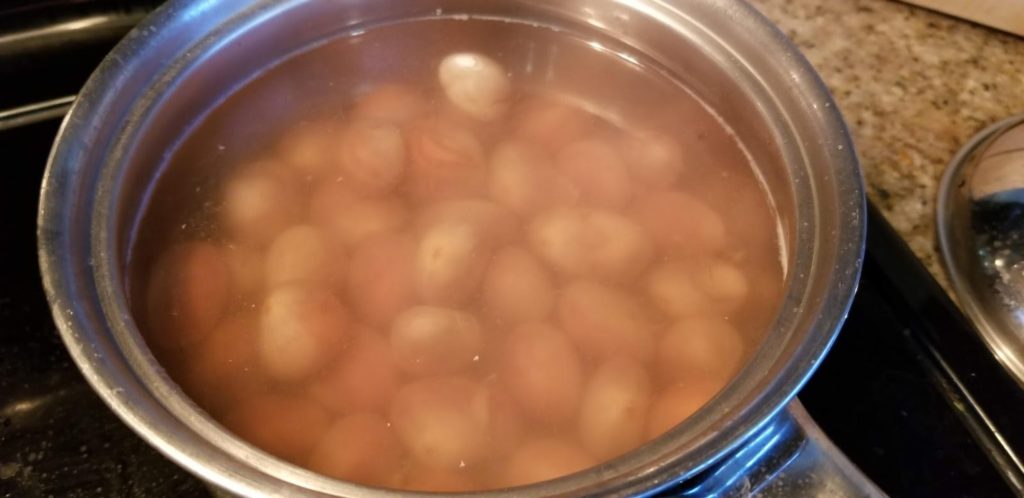
Boiled jackfruit seeds 
Oysternut hiding next to the chicken coop. 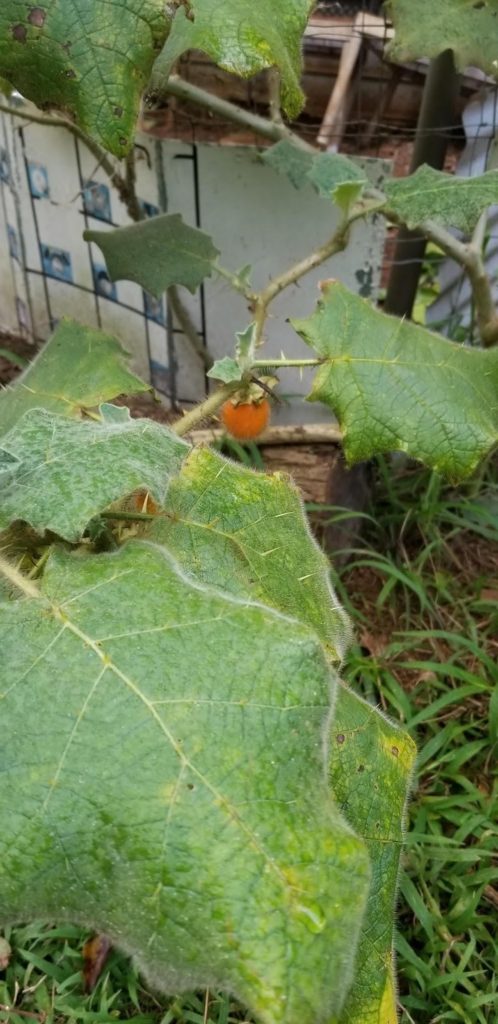
Vicious spines on the naranjilla 
More naranjilla 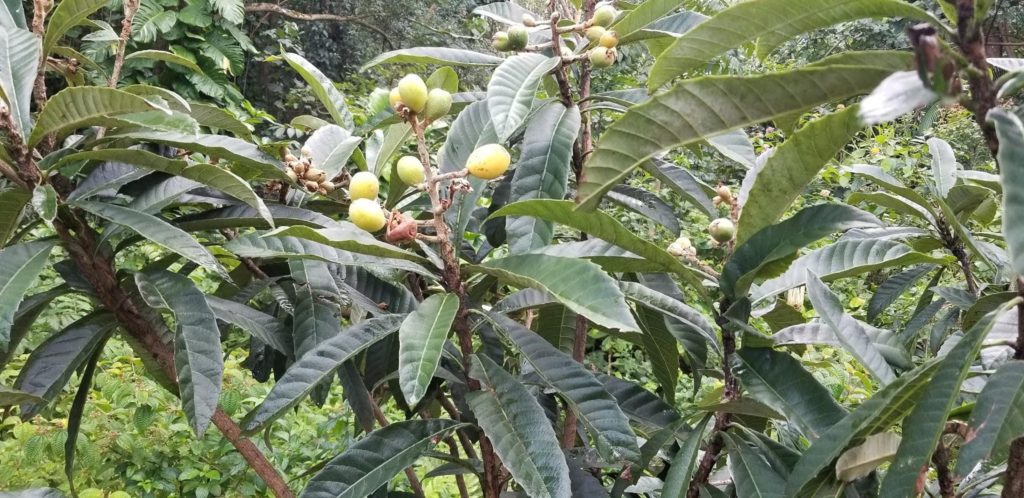
‘Obusa’ loquat 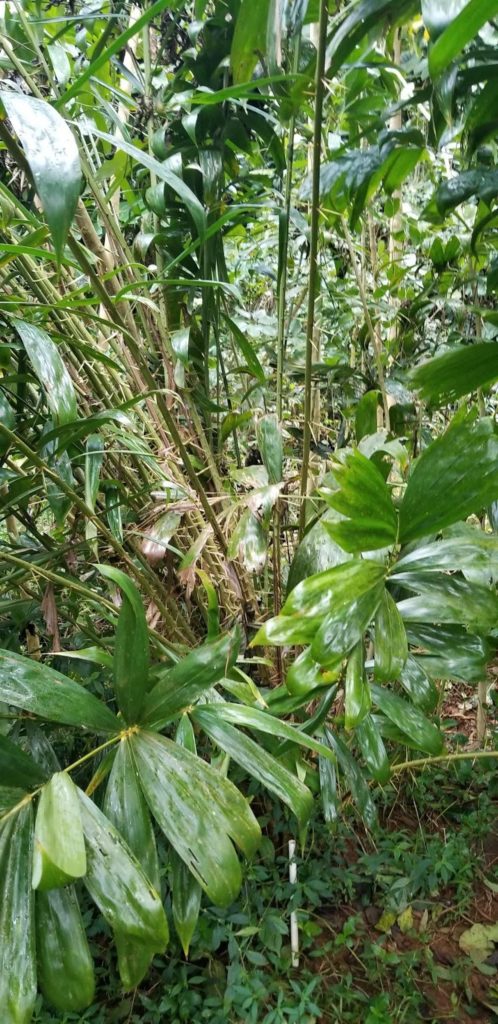
The snakefruit’s thorns make harvesting a dangerous dilemma 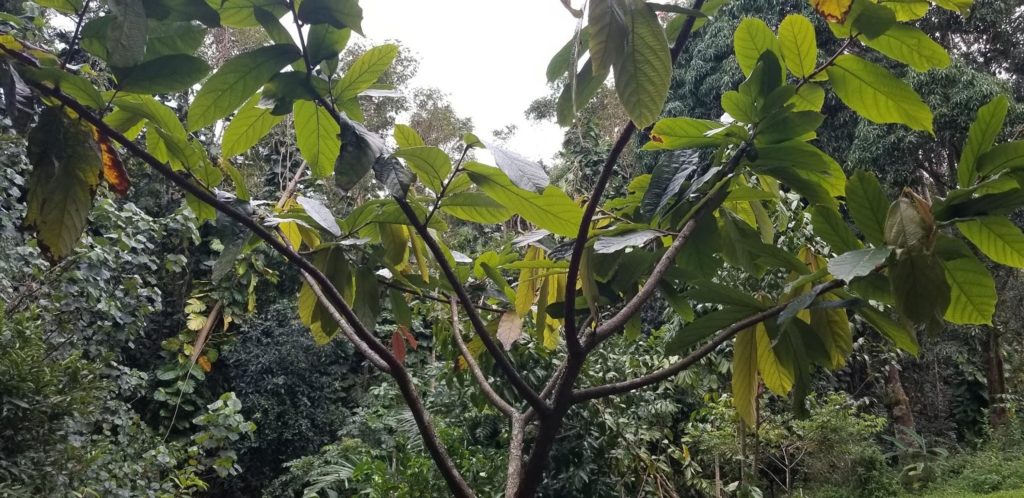
???? 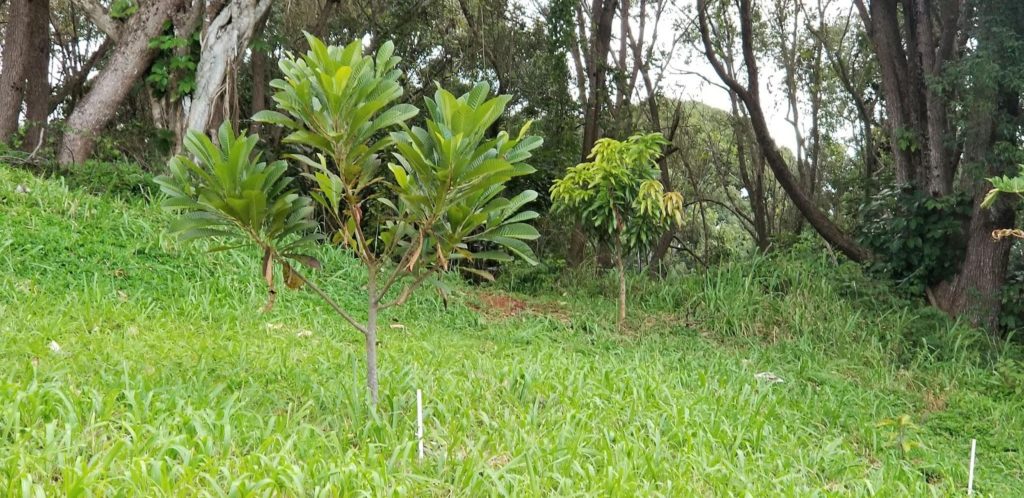
A young green sapote 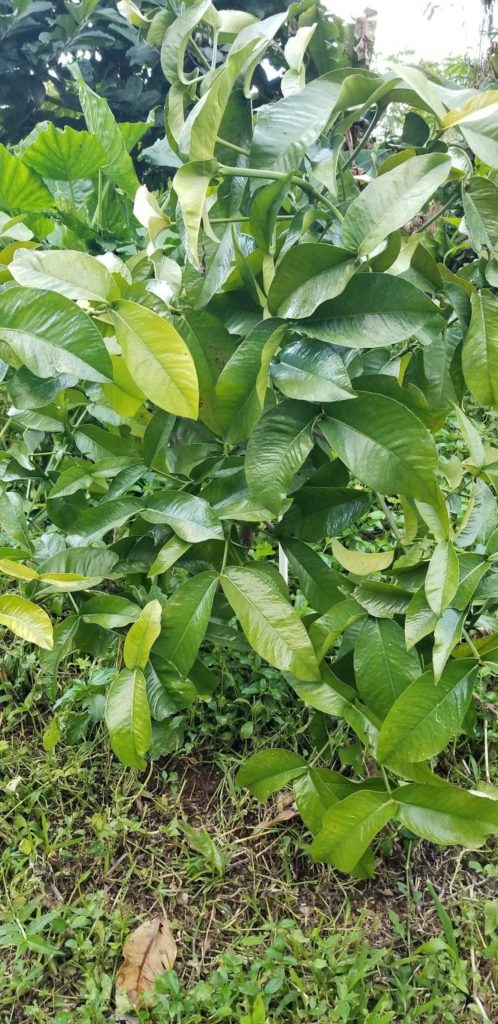
Some Garcinia 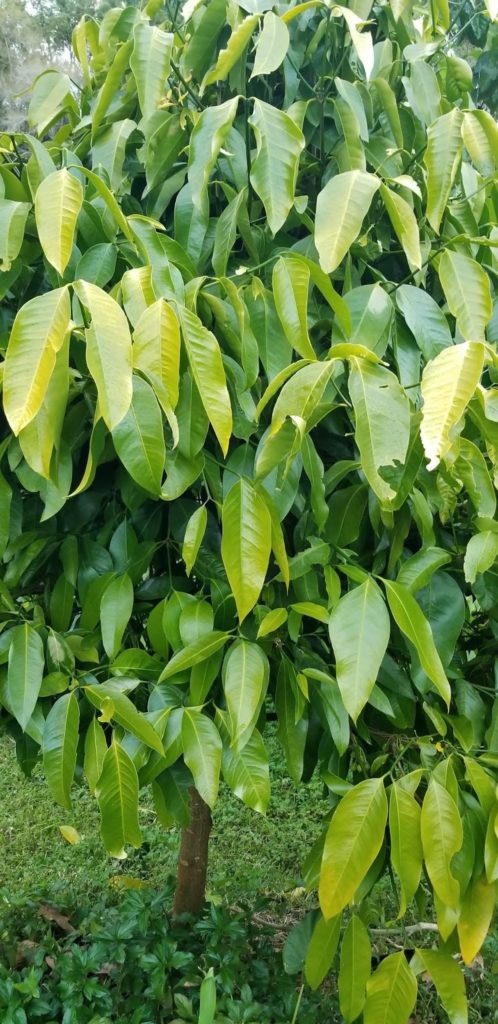
Yet another Garcinia 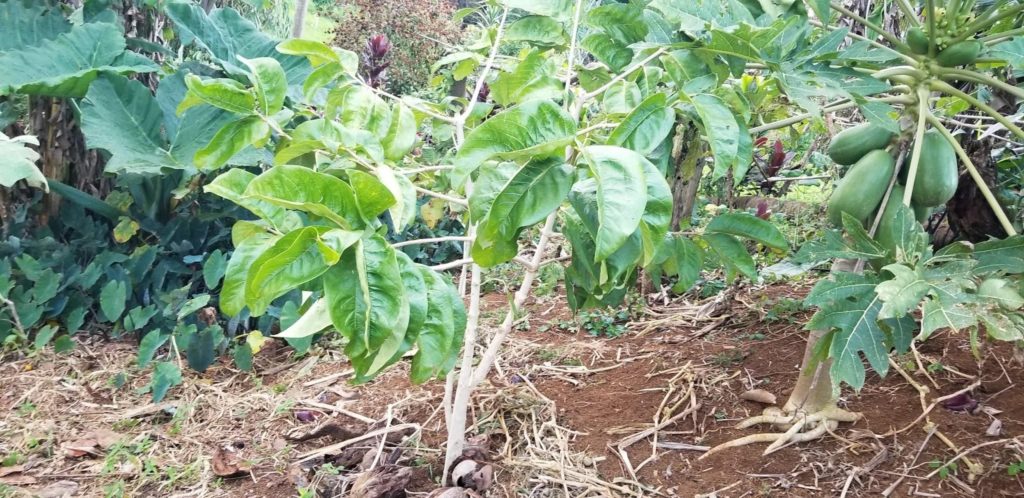
???
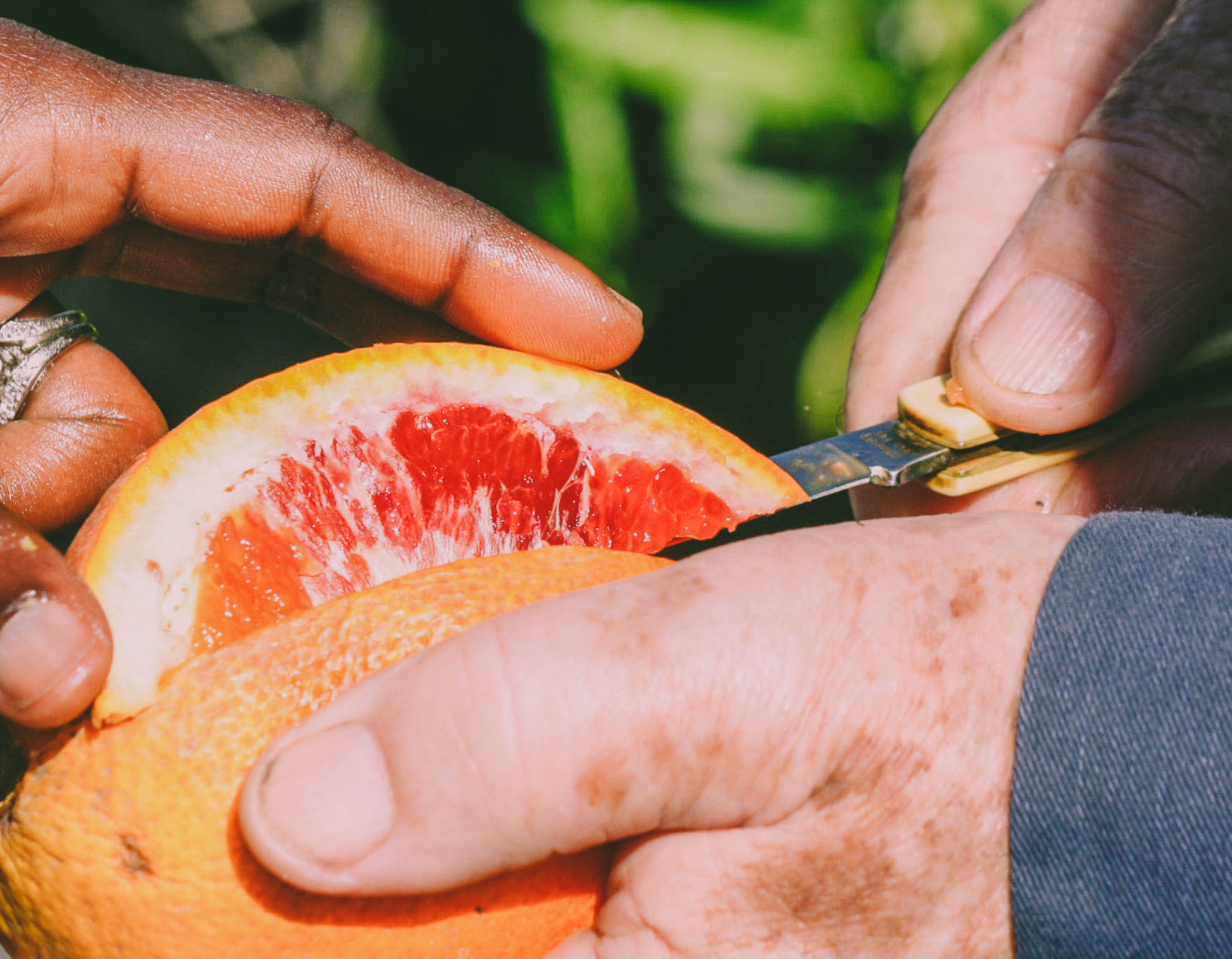
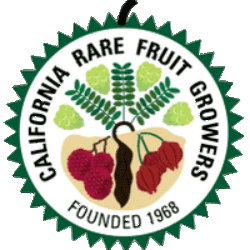
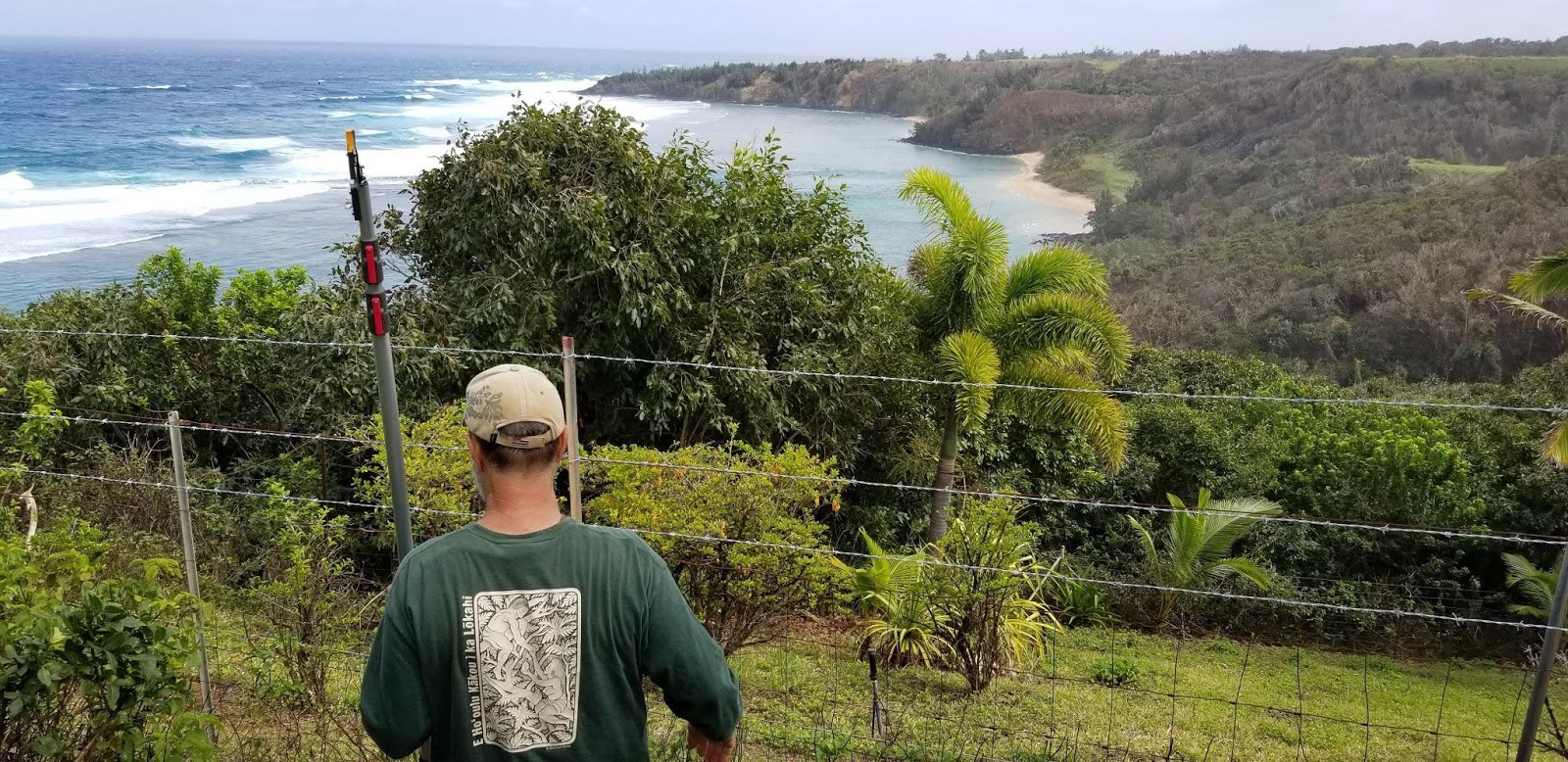

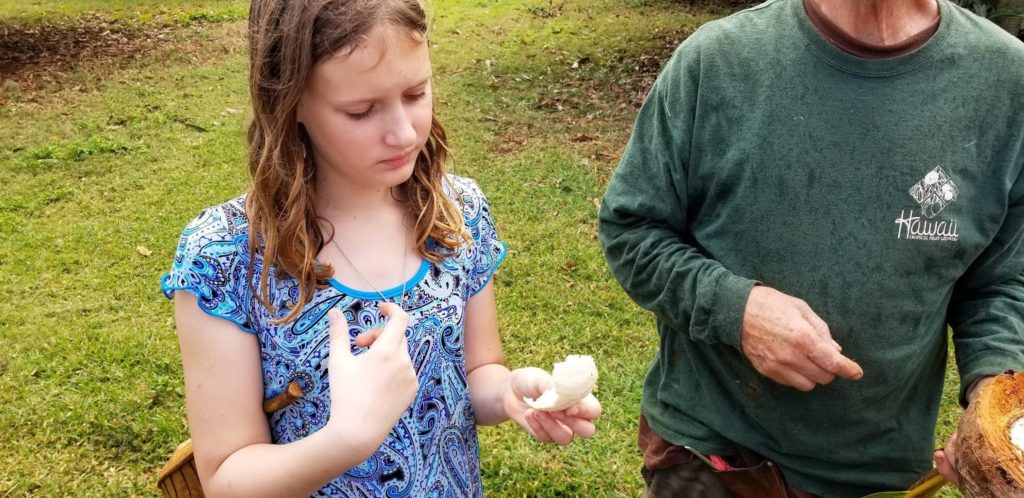
Lemon drop mangosteen is Garcinia intermedia.
Terminalia catappa, common name in Hawaii is usually Tropical Almond, not false Kamani.
Love your Kauai Plant Adventure!!!
Dave is amazing!!!
The first picture with “????” …
It’s a Cacao Tree ??
Mahalo
If I am interested in doing something similar ten days from now (fingers crossed domestic travel is not suspended) – what would be the easiest way to accomplish this? Thank you very much for any help and direction you are able to provide.